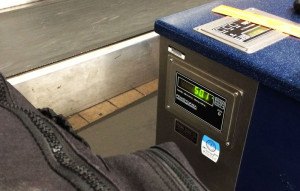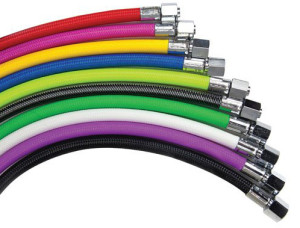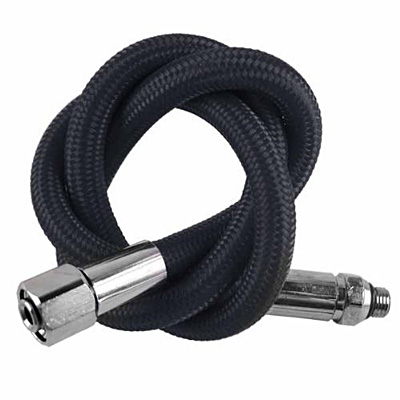Like many other divers, I always like to check out new innovations in dive gear, and one of my practical needs in recent years has been finding ways to reduce bulk and weight when traveling. A full set a dive gear in my roller bag usually comes in at just a bit under the 50 pound limit, and when I travel with my DSLR and housing kit in a Pelican case, I’ve used up my 2-bag limit, requiring everything else needed on vacation to be either tucked around my camera and dive gear or carried on.

My dive bag, weighing it at just over the limit (before using the foot-boost technique). Can you relate?
When the nylon-braided Miflex hoses became available, they piqued my interest for the potential benefit of being lighter and more compact. It wasn’t until last month that I finally bought a full set of them before taking a trip down to Cozumel and Playa Del Carmen. The full set of hoses (primary reg, octo, BC inflator, and SPG) cost just under $200, or around double what standard rubber hoses cost. They’re distributed by XS Scuba here in the U.S. and you can likely find them in your local dive shop.
The verdict? Money well spent. Simply put, I really like the Miflex hoses, for a number of reasons.
On the technical side, Miflex hoses are extremely tough and durable. They are manufactured with an inner liner layer of polyester and polyurethane compound line, which makes them stronger and gives them a proven lifespan longer than traditional hoses. Their low-pressure regulator hoses are manufactured to a burst test pressure of 3600psi, which is twice that of traditional hoses. Miflex hoses are approved to EN250 standards (European normative standard), and now have a 10-year track record on the market. During manufacturing, 30 individual safety tests are made during production on every hose.
On the practical side, the hoses are 30% lighter than traditional hoses and extremely flexible. Because of their flexibility, you can literally tie a Miflex hose into a knot and have uninterrupted airflow, with no kinking. While that won’t likely happen on a typical dive, their lighter weight and smaller profile do have several practical advantages.
Due to their lighter weight and flexibility, packing your regulator with Myflex hoses is easier. The hoses can be coiled into a much smaller space in your dive bag, and weigh a bit less as well. While diving, due to their lighter weight and slimmer profile, they have less drag in the water. This is most noticeable on your regulator, where there is less tug on your mouth when swimming forward or turning your head. It’s actually quite noticeable.
The Myflex high pressure hose is where you’ll likely see the most dramatic difference when compared to a traditional hose. The diameter is just 7.8mm (1/3 smaller than a traditional hose), has a burst pressure of 29,000 psi and a working pressure of 4,500 psi. The thinner, more flexible hose is very easy to route and while diving and makes it easier to adjust its position when looking at your gauges.
The early Miflex high pressure hoses had some manufacturing issues, with some reported to burst under pressure. These first generation hoses wee made with a swaged metal ferrule at the ends. The burst problem occurred there, at the end of the metal ferrule, either from unequal stresses or the hose getting bent hard against the end of the ferrule. Miflex remedied this problem, and the new versions no longer have this issue.
If you’re in the process of replacing your hoses, planning on a new regulator setup, or just want to upgrade your kit, take a look at moving to Miflex braided hoses. The benefits of lighter weight hoses with more flexibility and greater durability fit my needs well, and hopefully you’ll find the same.
(Editor’s note: I purchased these hoses at retail and not compensated for this product introduction/review)
– Chris
.


